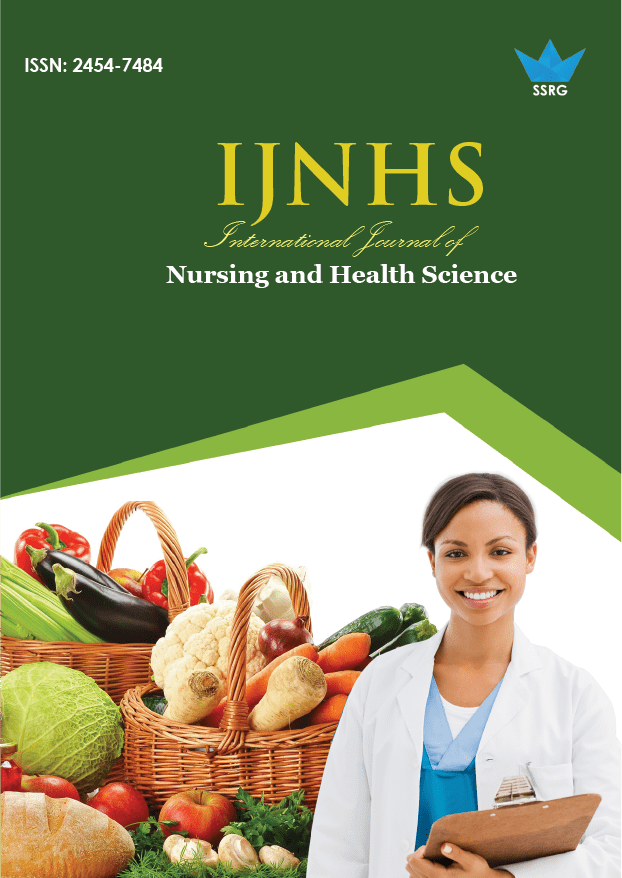Prevalence of Anemia in Relation to Body Mass Index (BMI) Among Students of Faculty of Nursing and Public Health, Bhutan

| International Journal of Nursing and Health Science |
| © 2017 by SSRG - IJNHS Journal |
| Volume 3 Issue 3 |
| Year of Publication : 2017 |
| Authors : Ripa Chakma, Deki Pem, Pasang Lhamo, Paromita Kundu, Krishna P. Sharma |
How to Cite?
Ripa Chakma, Deki Pem, Pasang Lhamo, Paromita Kundu, Krishna P. Sharma, "Prevalence of Anemia in Relation to Body Mass Index (BMI) Among Students of Faculty of Nursing and Public Health, Bhutan," SSRG International Journal of Nursing and Health Science, vol. 3, no. 3, pp. 6-8, 2017. Crossref, https://doi.org/10.14445/24547484/IJNHS-V3I5P101
Abstract:
A. Introduction: Anemia is an important cause of morbidity. This is a study to find out BMI and anemia among residential students of Faculty of Nursing and Public Health.
B. Method: A cross sectional study was conducted at Faculty of Nursing and Public Health from October to November 2015. A total of 153 students, 80 males and 73females, who stay in hostels, were included. The survey included collection of data on demographic parameter related to anemia, anthropometry (weight and height), and clinical and hematological assessment for anemia. Result: Female students with normal BMI were more anemic as compared to male students. The result indicates that having a normal BMI does not always indicate good micronutrient status. Conclusion: Female students are more anemic than males students and BMI has no association with anemia.
Keywords:
Anemia; Body Mass Index; Hemoglobin
References:
[1] World Health Organization (1991).National Strategies for Overcoming Micronutrient Malnutrition. Geneva: WHO.
[2] World Health Organization( 2011) Hemoglobin concentration for the diagnosis anemia and assessment severity , in cited Vitamin and Mineral Nutrition Information System (VMNIS), WHO reference number: WHO/NMH/NHD/MNM/11.1
[3] Jekielek, S., & Brown, B. The transition to adulthood: Characteristics of young adults ages 18 to 24 in America. Baltimore, MD: Annie E. Casey Foundation (2005).
[4] Clark, S. F. Iron deficiency anemia. Nutrition in Clinical Practice, 23(2) (2008) 128-141.
[5] Saxena, et al, Effect of gender on correlation of Anemia with body mass index in medical students Indian Journal of Physiology and Pharmacology, 55 (4) (2011) 364–369
[6] Paula Lagares Barreiro and Justo Puerto Albandoz (2001), Population and sample. Sampling techniques. Management Mathematics for European Schools 94342
[7] Physical Status : the use and interpretation of anthropometry. Technical Report series no 854, Geneva, World Health Organization, 1995.
[8] KalyanshettiSunita B., RajshekarKallurAssociation of anemia with BMI in medical students, a cross-sectional studyIndian Journal of Basic and Applied Medical Research; 6(1) (2016) 371-377
[9] Ayoubetal. Iron deficiency anemia in Dubai Medical College for Girls: a preliminary study.”J Egypt Public Health Assoc. 70(1-2) (1995) 213-28.
[10] UNICEF. (2006). ASituation Analysis of Children & Women in BHUTAN 2006. Published by UNICEF Bhutan.
[11] National Nutritonal Survey 2015, Ministry of Health, Thimphu, Bhutan
[12] National Nutritional Survey 2003, Ministry of Health, Thimphu, Bhutan
[13] Eftekhari M, Mozaffari-KhosraviH ,ShidfarF.The relationship between BMI and iron status in iron-deficient adolescent Iranian girls. Public Health Nutr., 12(12) (2009) 2377–81.
[14] Peter R, Kumar R, Sangwan and Pandey S. Prevalence of anemia and its correlation to body mass index: study among unmarried girls .International Journal of Basic and Applied Medical Sciences 2(3) (2012) 58-62.

 10.14445/24547484/IJNHS-V3I5P101
10.14445/24547484/IJNHS-V3I5P101